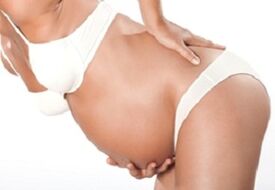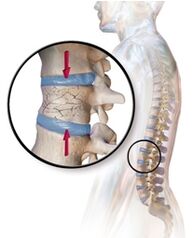Periodic or persistent back pain affects around 80% of the world's population. The problem is more common in women. The symptom is called lumbodynia. It is so common because of the constant high stress on the lumbar spine. He feels a pressure of 50 kg (in the supine position) to 220 kg when the person sits crooked. The problem indicates a lifestyle bias or serious illness. It gets worse with age and can lead to disability for the patient.

Physiological causes of pain
Complaints in the form of pain are the body's defense reaction. This is how it reacts to various "abnormal" internal processes that doctors call pathologies. The body hurts in an uncomfortable position and after physical exertion, and tells the brain that it is difficult for it to get the job done.
An uncomfortable position
Loin pain accompanies prolonged discomfort. The problem worries drivers and office workers as they spend a lot of time sitting when the lower back is exposed to maximum stress. A person has back pain from fatigue. If he does something in a hunched position for a long time.
The back hurts after sleeping if the sleeping place is poorly equipped. For example, the surface of the bed is too hard or too soft to provide adequate support for the spine and improve muscle relaxation.
Increased loads
The muscles and ligaments in the back can hurt. They support the spine in a stable position and are subjected to intense physical exertion. Conditions for the appearance of pain arise with sudden movements, accompanied by muscle tension in the lumbar region. This happens when a person carries weights, pulls heavy objects, lifts them up and down ("bend in half").
Muscles can also be stressful during exercise. When a person exercises a lot, their ligaments need time to recover. If there is no good rest, they wear out or become inflamed, which is signaled by the nervous system with pain.
Back pain in women
The problem of lumbar spine pain is very common in women as the beautiful half of humanity experiences it regularly under certain conditions. Menstrual abdominal pain is often accompanied by pulling discomfort in the lower back and sacrum. This is not associated with increased stress, but is a result of the production of prostaglandins (pain mediators). Before and during menstruation, the synthesis of mediators triggers hormonal changes in the female body.
in the female body.
Girls' lower back hurts when carrying a child (95% of pregnant women). It's not just the spine that is heavily stressed outside of pregnancy. The pressure on the lower back increases many times over as the woman's weight increases. The pregnant belly creates additional stress. It pulls the expectant mother's body forward and changes the distribution of the axial load. As a result, the woman's gait changes, lower back pain appears, the intensity of which increases with the duration of pregnancy. The loads increase in every position of the expectant mother, so a good rest on a quality mattress is extremely important to alleviate the woman's condition.
Hypodynamia
Symptoms often occur in people who do not exercise at all or lift heavy objects. The reason for this is the weakening of the muscular system. The back muscles must be strong in order to properly support the spine and to relieve it. If this does not happen, bone and cartilage tissue wears out faster, which is associated with pain.
Structural anomalies
The spine consists of a skeleton of bone tissue - the vertebrae. In between there are soft "layers" of cartilage tissue - intervertebral discs. Vertebrae provide strength and stability, cartilage - flexibility and elasticity of the spine. The main structural elements are hollow in the middle. The canal is filled with the spinal cord. All components are surrounded by blood vessels, nerve fibers. Pathologies in any element of the lumbar spine cause lumbodynia.
Osteochondrosis
The disease develops when the intervertebral discs wear out. The intervertebral discs of the lumbar spine are very often damaged by heavy loads. The most common causes of severe low back pain are bulges (subsidence) and hernias (damage and bulging of the contents) of the intervertebral discs, which pinch the nerve roots of the spine. Osteochondrosis affects people over the age of 35. The disease is particularly common in the elderly.
trauma
The lumbar spine is considered to be the strongest because it forms the main "axis" of the entire human body. However, falls and sudden movements are the most common injuries to the vertebrae in this section. Most spinal fractures and bruises are precisely located in the lower back.
Vascular damage
The vessels supply all tissues in the spine with nutrients. When its lumen narrows or overlaps, the trophic processes in the spine radically worsen. The result is inflammation, which is always expressed in pain.
Entrapment of nerves
In infectious diseases, nerve fibers can be damaged by damage to cartilage and vertebrae. Any pathology of the nerves is accompanied by sharp shooting and sometimes unbearable back pain.

Bone disease
Osteoporosis leads to calcium leaching and bone fragility. When the vertebral tissue is depleted, there is an increased risk of serious back injuries. In addition, osteoporosis can change the shape of the bones in the spine and increase pressure on the nerve roots.
Tumors in the vertebrae are another cause of pain. The most common type are hemangiomas. These benign neoplasms develop asymptomatically for a long time, but if the tumor becomes too large and extends beyond the vertebra, the patient feels severe pain.
Inflammatory processes
Arthritis can affect any joint in the body. The inflammation leads to joint damage and pain. It can be caused by advanced and chronic infectious diseases. Another cause of arthritis is autoimmune damage to connective tissue.
Internal problems
The lower back can hurt not just from diseases of the spine. Painful sensations related to pathologies of the internal organs or some systemic diseases can appear in the lumbar region.
Internal organs
Back pain is associated with kidney damage. Renal colic is accompanied by sharp and sharp pain on one or both sides of the back. More often it is felt just under the ribs in the back of the body.
Often, lumbar discomfort occurs against the background of intestinal diseases with inflammation of the pelvic organs (bladder, prostate - in men, ovaries and uterus - in women).
Systemic pathologies
Psoriasis and ankylosing spondylitis lead to lumbar pain. In these diseases, injuries occur in the structure of the connective tissue (cartilage). It loses its elasticity and therefore often becomes inflamed. Over time, the joints become dysfunctional and the nerve endings are under constant compression (impaired). In ankylosing spondylitis, the intervertebral spaces "harden".
Lower back pain can cause herpes zoster. Rashes with this disease appear on the shoulder blades, ribs, but most often - on the side surfaces of the trunk in the lumbar area. The first pain occurs before significant changes in the skin. If a blistering rash occurs, the symptoms worsen, complemented by itching. Even after the spots are completely gone, a person will still experience severe pain along the inflamed nerves. They can bother the patient for several months.
Tumors
Malignant lesions of the spinal cord and bones initially do not change the patient's condition. As the tumor grows and the atypical cells spread in the structure of organs and tissues, changes occur that affect the nerves. This manifests itself in severe pain. Discomfort in the lower back is felt not only with lesions of the lumbar spine, but also when the tumor grows in the internal organs innervated by the nerve ganglia from this department.
Nervous disorders
Lower back pain can be phantom (in other words, invented by the patient). This happens with psychoneurotic disorders. The psyche does not function properly against the background of shock, stress and persistent psycho-emotional stress. Discomfort can arise when a person makes himself sick, suffers from overwork. Such signs appear for the first time after a depression or a nervous breakdown and can be stressful for the patient for many years.
This is how you get rid of loin pain
If there are unpleasant sensations in the lower back, the patient should rest completely and reduce the intensity of the exercise. The symptoms usually subside or go away after a good recovery. This is a typical symptom of pain caused by an improper lifestyle and poor quality of rest. If the pain persists, you need to think about seeing a doctor.
The type of back pain is diagnosed by traumatologists, vertebrologists, and orthopedic surgeons. You can contact any of the specialists listed. At the first consultation, the doctor will interview the patient, examine him, conduct several tests (check the sensitivity of the nerves, the condition of the muscles). If a diagnosis cannot be made based on the information received, an additional examination will be scheduled. An x-ray is prescribed to assess the condition of the bone tissue. The structure of cartilage, nerves, the condition of the blood vessels and the spinal cord can be assessed using an MRI. If a systemic disease is suspected, the patient is prescribed laboratory diagnostics (general and biochemical blood and urine tests). Only after the correct diagnosis, the specialist will prescribe treatment.
Drug therapy
The list of drugs depends entirely on the diagnosis. To get rid of symptoms quickly, the patient is prescribed a brief course of pain medication (usually from the NSAID group). With severe inflammatory and autoimmune changes, glucocorticoid drugs are prescribed. For diseases of the cartilage tissue, chondroprotectors in injections or tablets are recommended. If the problem is with the muscles, muscle relaxants are recommended. To restore the work of nerve endings, B vitamins are prescribed.
The main treatment focuses on the cause of the pain. If it is caused by diseases of the internal organs, drug therapy corrects disorders of the kidney, gastrointestinal and genital organs. The symptoms go away when the underlying disease is eliminated. If the pain is unbearable, a nerve block is performed (analgesics are injected directly into the areas of the nerve roots).
To increase the effect of injections or tablets, external pain relievers (plasters, ointments, gels) can be prescribed. Such drugs can be used independently with recurrent lower back pain on a background of tension or increased stress. To relieve the condition, you can use pepper or menthol patches. They can also be used without a doctor's prescription.
Procedure
A specialist can recommend special treatments for low back pain. These include acupuncture, electrical current physiotherapy, ultrasound, therapeutic ultraviolet rays. In some cases, physical therapy exercises and massages are indicated. If the vertebrae are displaced, help from a chiropractor may be needed to reposition the bone. All procedures must be selected together with a doctor. It is forbidden to undergo treatment in which they act directly on the spine without diagnosing the disease. In this case, the procedures can not only be useless, but also harm the patient.
To prevent back pain, you need to monitor your spinal health from a young age. It is important to have proper weight on the back (to lift crouching objects and not bend over, to push heavy objects and not to pull them towards you). You should exercise moderately and choose exercises with a trainer. It is also important to treat infectious diseases in good time, to avoid stress, to take medication sensibly and as prescribed by a doctor.














































